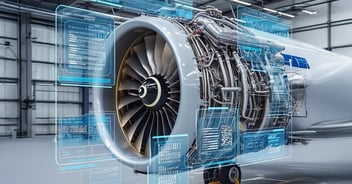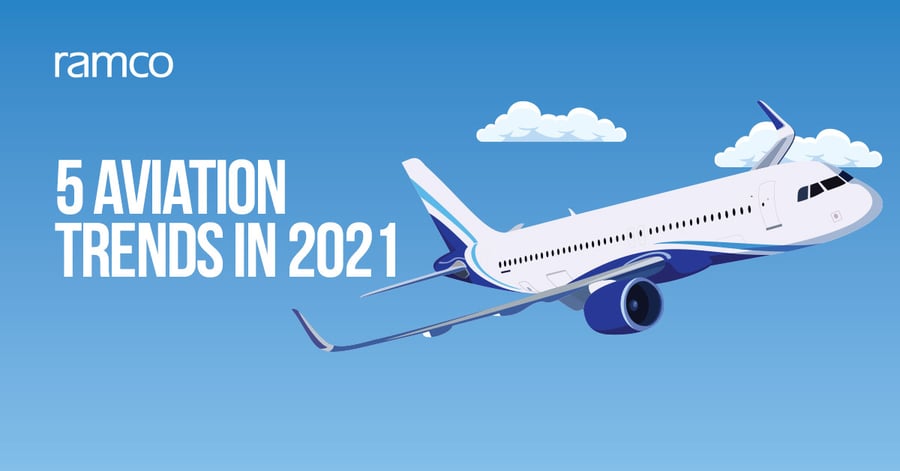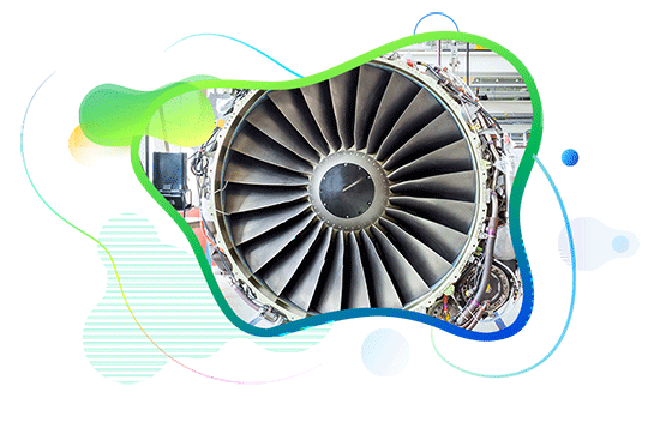
10 Things Aviation Industry Expects From Their Technology Partners
Published :

If 2020 is a coin for the Aviation Sector, there are 2 sides to it. On one side, we saw travel bans, parked aircraft, mammoth financial losses, supply chain shocks, furloughs, and job losses. On the other side, we saw companies shifting gears quickly by adapting to the new normal, finding new revenue channels, passenger-freight models, fast-tracking digital transformation programs to achieve excellent profit margins.
I feel a sense of pride in saying that we are working closely with aviation organizations that are on the second side of the coin, by fast-tracking digital transformation journeys. We managed to get onboard 10 new customers in 9 months (since April 2020) – from leading OEMs, MROs, Airlines, and Defense contractors like Iberia Maintenance, CHI Aviation, Tactical Air Support to 2 of the top 5 Aircraft Manufacturers, and one of the largest adversary air services providers to the U.S. DoD. I would like to share 5 key takeaways with regards to what the industry is looking for from its technology partners.
A couple of our large customers were using leading ERPs before choosing Ramco for their MRO operations, which were not meeting the requirements effectively. While some features were force-fitted within the Aviation ERP software with customizations, which only made things complex and ineffective, resulting in revenue leakages and increased turnaround times.
The matter of fact is that Aviation organizations like MROs, CAMO, Airline Maintenance functions, supply chain entities have unique operations that require specialized Aviation software that covers the whole gamut of functions such as Configuration Management, Engineering, Maintenance, Supply Chain, Safety Compliance, MRO & Part Sales, flight operations, employee records, and finance & accounting. This takes me to the next point.
If there is one thing that is common across all 10 wins, it is that Ramco replaced multiple systems in their IT landscape. Having disconnected and disparate systems is an IT nightmare for any organization as it increases the complexity to manage the IT systems, leads to inconsistency and inaccuracy in the enterprise-wide data, and hinders an organization’s growth.
Organizations are looking for a complete application suite that is still modular. That means they deploy specific modules for the current needs and when a need arises in the future for additional modules, they don’t have to look for another software but can deploy the other module within the same software they are currently using. Ramco might have displaced as anywhere between 3 and 15 systems at the new organizations.
Some airline industries have already conducted wearable technology experiments for cabin crew as well as engineers. LEDs are included in the former's uniforms to offer additional lighting in the event of an emergency and to display crucial information like flight numbers. Ground crew can deploy similar lighting in their jacket cuffs to aid in aircraft movement.
LEDs in jacket hoods can help engineers illuminate work areas while leaving both hands free for inspection and maintenance. Air quality sensors allow users to monitor their work environment, while in-built cameras and microphones allow remote colleagues to assist with troubleshooting technical issues. While the advances are quite simple, the result improves safety and speeds up maintenance and repairs, resulting in cost savings for the airline.
A solid Aviation ERP software combined with a mobile platform that is used for day-to-day operations of key personnel such mechanics, store managers, pilots, executives is the ask from organizations. For it brings in a lot of efficiencies and eliminates unproductive time from the operations. The best among all mobile apps is for mechanics.
Right from task assignment notification to accessing PDF task cards to execution and work sign off, parts request to fulfillment, discrepancy reporting to corrective action, and collaborating with fellow technicians, Aircraft Mechanics can pretty much do their work on a mobile device which is a game-changer in reducing execution times in a big way. Now, imagine the exponential benefits organization gets if all key functions start using mobile apps!
Some airlines utilize maintenance drones to speed up and streamline inspections. They can evaluate lightning-strike damage in less than 30 minutes, as opposed to the 4 to 6 hours it takes to do it manually. Drones may also scan fuselages, verify that parts are in good working order, and arrange repairs. Drone photos of aircraft components, according to some analysts, might be matched to online image databases, allowing problems to be spotted automatically. In the future, unmanned aerial vehicles could be used to deliver spare parts, reducing sourcing periods and speeding up repairs.
Also Read: eVTOLs and UAVs: The role of ERP in this emerging industry
When I attended industry events in 2019, the delegates were emphasizing on aviation emerging technologies like Artificial Intelligence and Machine learning, and a little on Blockchain. Today, as I write this article, I can say for sure that a shift is happening across the organizations who are evaluating solutions/software based on how futuristic they are.
During the evaluation, there is great importance that’s placed on use cases developed with these technologies. It would not be an exaggeration to say, software organizations will be evaluated based on the investments made in these technologies and successful proof of concepts done at customer organizations, in the days to come.
New technology in aviation industry is now being used by flight operators to optimize their itineraries and reduce emissions. Future advances are even more intriguing, with a solar-powered jet having already completed a circumnavigation of the globe. It's a significant step toward reducing airlines' dependency on fossil fuels, but the world's first solar-powered commercial aircraft is unlikely to appear for several years.
Tech Giants are introducing seamless Inflight Connectivity to digitize the international airport experience and keep passengers relevant. Reimagining the Wi-Fi scenario at 40000 feet above the ground is nothing short of incredible. It would amuse the travelers and bring them one step closer to the entertainment platform, allowing them to watch high-definition movies, series, matches, play games, and so on. Not only that, but business people can save time and continue their online-based office work without interruption.
In 2011, pilots began using mobile devices as electronic flight bags, allowing them to access e-documents rather than the hard copies of charts, flight manuals, and other material they had previously relied on. Electronic equipment soon helped pilots become more productive and significantly decreased aircraft weight.
However, managing the massive amount of documentation necessary by pilots and cabin crew can fly costly, time-consuming, and challenging for airlines (and are required by regulators to have). Even if an airline has invested in document management software, it must still devote significant effort each year to monitoring electronic document libraries and ensuring that all data is accurate.
I am sure you agree with me ‘Digital Transformation’ has been the most overused and abused word for years! Different people define it in different ways! Studies from leading analysts like McKinsey show that a staggering 70% of digital transformations fail.
Also Read: How did COVID-19 accelerate Digital Transformation in Aviation Maintenance organizations?
While key reasons for the failure of these programs are due to lack of employee engagement, inadequate management support, poor cross-functional collaboration, and a lack of accountability, there seems to be a shift in terms of management’s interest and clarity in terms of what they mean by digital transformation and the business outcomes that are tied to these programs. For example, in an Aviation MRO organization, the outcome attached would be reducing the time spent on maintenance execution activity of an Airframe/engine or component. This can be achieved by deploying digital task cards in a mobile platform and prepositioning the material required based on predictive demand, electronic certifications, and releases.
To realize the benefits at scale, these core functions can be supported by automating the non-core and administrative functions within the organization like technical records, work planning, order processing, assignments, reviews, and approval functions.
To summarize, digital transformation programs with clear set business objectives are becoming the top agenda items at C-level meetings.
Integration of Predictive Analytics and IoT in Aviation ERP Software
The aviation industry is increasingly leveraging predictive analytics and the Internet of Things (IoT) to enhance operational efficiency, safety, and profitability. Integrating these technologies within aviation ERP software and aviation maintenance software enables real-time monitoring, intelligent forecasting, and predictive maintenance—ushering in a new era of proactive decision-making.
Predictive Maintenance: Reducing Downtime, Increasing Asset Utilization
Modern ERP solutions in aviation are embedding advanced analytics to monitor aircraft health in real time. By collecting data from IoT-enabled sensors embedded in aircraft systems, the aviation ERP software can identify anomalies and predict component failures before they happen. This not only avoids costly unscheduled downtime but also extends the lifecycle of critical components. With accurate data-driven insights, maintenance schedules are optimized, labor resources are better allocated, and compliance is assured.
IoT-Driven Insights for Real-Time Asset Tracking
Software in aviation now includes features that allow for real-time tracking of aircraft parts, tools, and ground support equipment. This is made possible through RFID tags and IoT-enabled devices that send location and usage data to the centralized ERP system. Aviation maintenance software then uses this data to streamline inventory management, improve turnaround times, and ensure tools are calibrated and available when needed.
Enhanced Decision-Making and Safety Compliance
By integrating predictive analytics with aviation ERP software, aviation companies can uncover trends, anticipate demand, and minimize operational disruptions. These intelligent systems help prioritize maintenance tasks, reduce manual errors, and enforce safety protocols through automated compliance checks. The result is a robust, insight-driven environment that ensures regulatory adherence while driving strategic efficiencies.
As aviation organizations strive to become more agile and resilient, the fusion of IoT and predictive analytics within software aviation platforms will remain a cornerstone of their digital transformation strategy. These intelligent capabilities not only support technical operations but also elevate overall business outcomes through informed, data-backed decisions.
The approach of the aviation industry towards technology has significantly shifted due to innovations in aviation ERP software as well as aviation maintenance software. At such a time, the organizations in this aviation sector need those solutions which can adapt quickly. Traditional ERP systems are not designed with the unique needs of aviation companies related to managing maintenance and supply chains or ensuring regulatory compliance in mind. Aviation ERP software meets the need for a customized solution in achieving minimum turnaround times while ensuring comprehensive compliance.
One area that stands out when aviation companies embrace digital transformation is the use of aviation maintenance software to maintain specific maintenance and repair operations. Aviation maintenance software keeps track of full aircraft lifecycles, from engineering and configuration management to sales of parts and compliance with safety regulations. An ERP solution specifically designed for the aviation industry can consolidate many disparate systems into one all-inclusive platform that will combine all functionalities, thereby ushering in better data accuracy, faster decision making, and reduced complexity from multiple systems management. For avionics, efficiency and speed minimize downtime throughout operations and maintain aircraft safety.
To this, nowadays, aviation ERP software is gaining more in the sense of infusing advanced technologies like Artificial Intelligence (AI), and Machine Learning (ML), which predict maintenance requirements, have enhanced the operation efficiency of airlines and optimize flight routes. For example, AI tools can analyze historical data and sensor readings so that equipment failures can be predicted even before they can have any kind of chance. On the other hand, with the help of ML models, proper decision making will be done in real time, so that aircraft operations will happen as efficiently as possible. Of course, these technologies will save massive amounts of money, reduce turnaround time, and increase safety for flight companies. Improved aviation maintenance software will keep the competitiveness of an organization and meet stringent regulatory standards-this is what is changing the face of the industry and moving it to achieve digital transformation.
Enterprise asset management (EAM) involves the management of mission critical assets of an organization throughout each asset's lifecycle. EAM is used to plan, optimize, execute, and track the needed maintenance activities with the associated priorities, skills, materials, tools, and information. The aim is to optimize the quality and utilization of assets throughout their lifecycle, increase productive uptime and reduce operational costs.
Enterprise asset management (EAM) involves the management of the maintenance of physical assets of an organization throughout each asset's lifecycle. EAM is used to plan, optimize, execute, and track the needed maintenance activities with the associated priorities, skills, materials, tools, and information.
The software helps in effective maintenance of assets through preventive, predictive, shutdown and breakdown maintenance strategies. The system also helps enterprises mitigate equipment risks by enhanced safety standards. The streamlined operations and improved asset performance helps organizations increase their investment effectiveness.
EAM is important because it helps organizations track, assess, manage and optimize asset quality and reliability. Asset intensive Organizations have hundreds, thousands, even millions of assets which needs to be maintained to maximize / optimize life of these assets to increase the return on investment.
The key features of effective EAM are:
Asset Intensive companies under the following Industries :
Contact us for a meeting and schedule a demo
This differs on case to case basis, based on the type of installation and unique industry specific requirements. Contact us for a meeting and schedule a demo.
This differs on case to case basis, based on the type of installation and unique industry specific requirements. Contact us for a meeting and schedule a demo.
Stay Connected, follow us on LinkedIn / Twitter to know more about EAM Software latest trends.

Prakash Babu Devara is Head of Aviation Marketing at Ramco Systems, bringing over 15 years of experience in marketing and branding. With a passion for aviation and technology, he is dedicated to bringing the best of both worlds together to drive value proliferation. Prakash has a proven track record in developing and implementing effective marketing strategies, building strong brands, and driving business growth. In addition to his role at Ramco, he is an aviation blogger and a seasoned public speaker known for communicating complex ideas clearly and engagingly.

All Rights Reserved. © Copyright 2024. Ramco Systems.